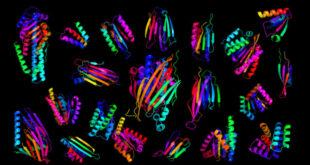Bacteria thrive in showerheads and throughout household water distribution systems. While most of these bacteria are innocuous, some are potential pathogens, including members of the genus Mycobacterium that can cause nontuberculous mycobacterial (NTM) lung infections. In a new study published in the journal mBio, a researcher team led by University of Colorado, Boulder scientists found that showerheads often harbor abundant mycobacterial communities that vary in composition depending on geographic location, water chemistry, and water source. They also identified geographic regions within the United States where showerheads have particularly high abundances of potentially pathogenic lineages of mycobacteria, and these ‘hot spots’ generally overlapped those regions where NTM lung disease is most prevalent.
Mycobacteria are frequently abundant in showerheads, and many showerheads harbor mycobacterial lineages that include known pathogens.
“Bacteria grow and persist in biofilms coating the inside of showerheads and shower hoses despite the seemingly inhospitable conditions found in these habitats,” said study lead author Dr. Matthew Gebert of the Cooperative Institute for Research in Environmental Sciences at the University of Colorado, Boulder and colleagues.
“These bacteria must tolerate rapid temperature fluctuations, long intervals of stagnation or desiccation followed by high-shear turbulent flow events, and the low nutrient and organic carbon concentrations typical of most drinking water.”
“In many cases, showerhead-associated bacteria must also be able to tolerate residue from the chemical disinfectants — including chlorinated compounds — which are often added to municipal drinking water to limit bacterial contamination.”
“Most of the bacteria that can become aerosolized and inhaled when the shower is in use are likely harmless. However, this is not always the case.”
“Bacteria within the genus Mycobacterium are commonly detected in showerhead biofilms and throughout the water distribution system.”
There are nearly 200 described species of NTM mycobacteria, which are defined as any members of the genus that are not Mycobacterium tuberculosis or M. leprae — which cause tuberculosis and leprosy, respectively.
Despite their importance, the diversity, distributions, and environmental predictors of showerhead-associated mycobacteria remain largely unresolved.
To address these knowledge gaps, Dr. Gebert and co-authors worked with citizen scientists to collect showerhead biofilm samples and associated water chemistry data from 656 households located in the United States and 13 countries in Europe.
They found that showerheads often harbor abundant mycobacterial communities that vary in composition depending on geographic location, water chemistry, and water source.
Households that received water treated with chlorine disinfectants had particularly high abundances of certain mycobacteria.
“By harnessing DNA sequencing technology, we were able to identify which bacterial species that lived in showerhead slime, and how abundant they were,” the study authors said.
“Mycobacteria were far more abundant in showerheads receiving municipal tap water than in those receiving well water, as well as more abundant in U.S. households versus European.”
“These patterns are probably driven in part by differences in the use of chlorine disinfectants. Mycobacteria tend to be somewhat resistant to the chlorine-based disinfectants used more heavily in the United States than in Europe — so in Europe, other bacterial species may be better able to thrive and outcompete the disease-causing strains.”
“Showerhead materials seemed to matter, too, with more mycobacteria in metal showerheads than in plastic ones — plastic leaches some chemicals that support diverse bacterial communities, possibly preventing the mycobacteria from becoming too abundant.”
When the researchers mapped out where potentially pathogenic mycobacteria thrived, the maps revealed ‘hot spots’ that roughly match regions where NTM lung disease is most prevalent — parts of Southern California, Florida, and New York, highlighting the potentially important role of these showerhead bacteria in disease transmission.
“Our results highlight the public health relevance of mycobacteria in showerhead biofilms and advance our understanding of NTM transmission dynamics,” they said.
“This study demonstrates that mycobacterial distributions in showerhead biofilms are often predictable from household location and water chemistry.”
“The results will help develop strategies to reduce exposures to these emerging pathogens.”
_____
Matthew J. Gebert et al. Ecological Analyses of Mycobacteria in Showerhead Biofilms and Their Relevance to Human Health. mBio, published online October 30,2018; doi: 10.1128/mBio.01614-18
 #Bizwhiznetwork.com Innovation ΛI |Technology News
#Bizwhiznetwork.com Innovation ΛI |Technology News




